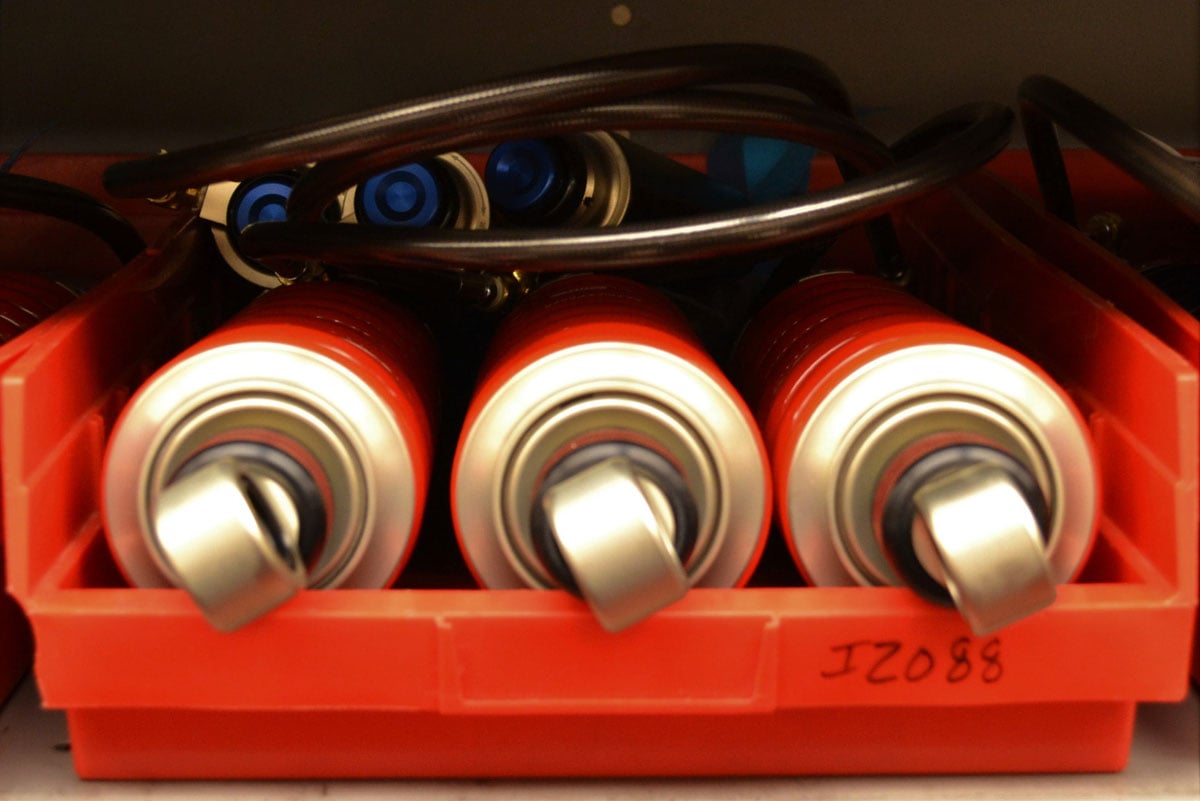Racing Shocks Explained in Less than 10 Minutes

June 13, 2022

Have you waited too long to ask about the ins and outs of racing shocks, and now you’re too afraid to ask? Don’t worry: That’s what we’re here to help you with.
Without a proper understanding of racing shocks, their function, and how to maintain them, you’ll find yourself bottoming out at best and wiping out at worst. Shocks are a vital element of your overall race car setup.
Welcome to Racing Shocks 101. This post will give you all the information you need to feel confident purchasing, maintaining, and talking about racing shocks.
Racing Shocks: The Basics
Before we discuss the nitty-gritty details of racing shocks, let’s start with a broad question: What is the purpose of racing shocks?
In racing, shocks have two main purposes:
- Stabilize the Chassis: Shocks help to keep things steady when driving over bumps in the track. If they’re too tight, you can lose traction due to an airborne tire. If they’re too soft, the chassis can bottom out on the track.
- Control Understeer and Oversteer: Your shocks will also impact the amount of weight allowed to sit on one corner of the chassis.
In short, racing shocks are designed to keep your tires on the racing surface. To understand any discussion of racing shocks, there’s some key terminology you’ll need to understand. Some of the basic terms we’ll use in today’s post include:
- Damping: This is how your shock reduces the wave amplitude produced by the chassis after hitting a bump.
- Compression: This refers to when the shock length grows shorter.
- Rebound: This refers to when the shock lengthens again after compressing.
- Velocity: Specific to racing shocks, velocity refers to compression or rebound speed. This measurement is described in terms of inches per second.
Armed with these basics, we’re ready to dive into some of the more specific elements of racing shocks. We’ll be discussing their design, how to read the numbers on your shock performance, shock maintenance, and more.
FREE DOWNLOAD - Damper Tuning Guide (Starter)
Ensuring a well-tuned damper setup can translate to significant performance gains on track. If you are unsure of where to begin the tuning process, this is a great starting point. Maximize the results of your shock adjustments with our free damper tuning guide download.
Parts of a Racing Shock
A racing shock is comprised of various parts. The composition of these parts will vary slightly based on the style of shock, but the parts present in every shock setup include:
- Piston: The sliding cylinder inside the shock that moves back and forth against fluid pressure.
- Shims: Flexible discs that serve a multitude of functions and come in a variety of diameters.
- Hydraulic Fluid: An oil-based substance that reduces friction, transfers heat, seals clearances, and more.
- Bleed Valve: A valve that allows a controlled leak path to reduce pressure and helps control compression and rebound.
These parts work together to help the racing shocks work as a whole. The piston pushes the fluid through the valves, controlling the rate of the shock. You can vary your valves, shims, and bleeds to control this rate. Your shocks will use different valves and bleeds for compression and rebound.
FREE DOWNLOAD - Bleed Shim Equivalence Chart
In this free download, we outline the different ways to achieve bleed, the advantage of bleed shims, and provide our charts to give you a comparison of our notched bleed shim vs. bleed hole for pistons.
Types of Racing Shocks
When discussing the different types of racing shocks, the conversation boils down to two main designs: Monotube vs. Twin-tube. Let’s discuss each of these designs in a little more detail, diving into the differences between them and the pros and cons of each option.
Monotube
In monotube shocks, the shell cases work as a cylinder, housing the piston valve, oil, and gas that makes the shock work as designed. As the name suggests, it is a single tube containing a floating piston whose job is to separate the oil and gas chambers of the cylinder.
A monotube shock also does not have a compression valve. The piston that divides the oil and gas chambers does the job of that compression valve instead.
Pros: Monotube shocks are simpler to install because they can be installed upside down or right-side up. This type of shock also performs better on rougher tracks.
Cons: This type of shock is more expensive as they are generally custom-built for a specific application.
Twin-Tube
In the twin-tube design, you’ll have two separate cylinders nested inside one another. The first sits inside a shell case containing the piston valve. Sometimes, the inner tube is called the “pressure tube,” and the outer is referred to as the “reserve tube.”
Your twin-tube design has no piston or barrier between the gas and oil chambers. Instead, you’ll have a compression valve, restricting the flow of the hydraulic fluid. The fluid will move between the different chambers through small holes in your piston.
Pros: Twin-tubes have the advantage when it comes to situations with minimal gas pressure. This option is less expensive, as they are mass-produced.
Cons: Constant pressure on the shock can result in foaming, which causes your damping to become weaker, resulting in handling issues. This type of shock also doesn’t perform as well on a rough track.
Reading Shock Numbers
We can’t talk about shocks without talking about the numbers. Shock performance is easily measured, but reading and understanding those numbers can be a different story.
Your shock number readings are called valving numbers. What are valving numbers? Simply put, these numbers indicate how much force you need to compress or extend a shock.
You can measure these numbers using a tool called a shock dyno. A shock dyno oscillates the shock at different speeds, and the tool then measures the force of the shock at various velocities.
You’ll get readings for both compression and rebound velocities. However, you must be careful when reading your results. Some software prints graphs with the compression figures on top and the rebound below, whereas others print the results the other way around.
Also, remember that your shock rating system will vary by brand. Most use force damping at three inches per second velocity when rating shocks.
FREE DOWNLOAD: How to Read a Shock Dyno Graph
In this free download, we outline how to read a dyno graph and, more importantly, what it can tell you about how your shock is performing.
Shock Maintenance
Even standard vehicles require some maintenance on their shocks. For racing vehicles, maintenance must be much more frequent—and more in-depth.
The maintenance required for your shocks will vary based on a few elements. Most importantly, your racing type and track surface. For example, your shocks will have different maintenance needs if you race on dirt vs. pavement.
Basic racing shock maintenance involves five key steps:
- Remove and inspect shocks regularly.
- Ensure shocks can be fully extended and compressed.
- Check for soft spots or binds.
- Check the shock for leaks and dents.
- Measure shock performance with a shock dynamometer at least once per year.
Beyond regular, routine maintenance, you should also explore shock tuning. With the help of an expert or a guide, you can adjust your shock setup, testing for driver feel, handling, and more.
When you explore shock tuning, you’re essentially trying to control the rate at which your wheels move up and down. By mastering suspension tuning, you can control your feel. You can tune for a stiffer shock rate, slowing spring movements to avoid bottoming out, or softer shock rates, allowing faster movement and improving traction.
Check out our ON-DEMAND WEBINAR: Top 10 Most Common Suspension Issues & How to Resolve Them
In this free webinar, we review the most common suspension issues you're likely to encounter and tips for how you can resolve or avoid them altogether.
Handle Your Racing Shocks The Right Way
Maintaining your racing shocks can feel intimidating, but when you arm yourself with the right information and take the right approach, it doesn’t have to be difficult. The first step to handling your racing shocks the right way is to consider where you’re sourcing your parts.
No matter what sort of racing you do, you’ll need race-specific shocks to keep your chassis steady and your tires on the pavement. At Penske Racing Shocks, we know that no two vehicles or drivers are alike, so we tailor your shocks to you. With our S3 program, you can not only get customized racing shocks but also receive setup assistance and long-term support from our shock experts.
Read more about our S3 program, or get started with us today.


%20(1).png?width=1080&height=1080&name=Heritage%20Cruiser%20Shock%20-%20IG%20(1)%20(1).png)